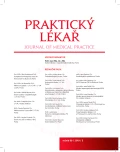Diagnostics and treatment of laryngeal carcinoma
Authors:
B. Maxová; A. Čoček
Authors‘ workplace:
Thomayerova nemocnice, Praha, ORL oddělení, Primář: MUDr. Jan Paska, MBA
Published in:
Prakt. Lék. 2019; 99(5): 201-204
Category:
Reviews
Overview
Head and neck tumours are newly diagnosed approximately by 2000 patients in Czech Republic every year, they are the 6th most common by men and 17th by women (1). The incidence of laryngeal carcinoma is around 8,8/100 000 inhabitants (mortality 4,1/100 000), which hasn‘t changed in the last few years. Men are affected 9× more than women, mostly in the age of 55–70. The extrinsic factors play the main role in aetiology. The foremost risk factor is tobacco use. The combination with ethanol consumption has strong synergistic effect. Another risk factor is HPV infection. In 95% of malignant laryngeal tumours it is squamous cell carcinomas we talk about. The prognosis is affected by the localization, but much more by the size of neoplasia. That is why the early diagnose is of such a significance here. Newly developed endoscopic examination methods enable us to explore the neoplastic changes of mucosa, such as the narrow band imaging (NBI), autofluorescence and contact endoscopy. The actual trend in therapy of laryngeal carcinoma is focused on larynx-preserving methods.
Keywords:
endoscopy – head and neck cancer – laryngeal squamous cell carcinoma – narrow band imaging – larynx preserving therapy
Sources
1. Masarykův onkologický ústav. Rakovina hlavy a krku [online]. Dostupné z: https://www.mou.cz/c32-nadory-hrtanu/di47 [cit. 2019-09-02].
2. Hybášek I. Ušní nosní a krční lékařství. Praha: Galén-Karolinum 1999.
3. Jeřábek L. Incidence duplicitních zhoubných nádorů v ORL oblasti a jejich možná etiopatogeneze. Otorinolaryng a Foniat 2001; 50(1): 5–9.
4. van Oijen MG, Slootweg PJ. Oral field cancerization: carcinogen-induced independent events or micrometastatic deposits? Cancer Epidemiol Biomarkers Prev 2000; 9(3): 249–256.
5. Nonaka S, Saito Y, Oda I, et al. Narrow-band imaging endoscopy with magnification is useful for detecting metachronous superficial pharyngeal cancer in patients with esophageal squamous cell carcinoma. J Gastroenterol Hepatol 2010; 25(2): 264–269.
6. Johnson JT. Malignant tumors of the larynx [online]. Dostupné z: https://emedicine.medscape.com/article/848592-overview#showall [cit. 2019-08-30].
7. Čoček A. Vývoj koncepce léčby karcinomu hrtanu [online]. Dostupné z: https://zdravi.euro.cz/clanek/postgradualni-medicina/vyvoj-koncepce-lecby-karcinomu-hrtanu-369033 [cit. 2019-08-30].
8. Lukeš P, Lukešová E, Zábrodský M, a kol. Endoskopické optické zobrazovací metody v diagnostice nádorů hrtanu. Čas. Lék. čes. 2017; 156(4): 192–195.
9. Sano Y, Kobayashi M, Hamamoto Y. New diagnostic method based on color imaging using narrow band imaging (NBI) system for gastrointestinal tract. Gastrointest Endosc 2001; 53(5): AB125.
10. Ni XG, He S, Xu ZG, et al. Endoscopic diagnosis of laryngeal cancer and precancerous lesions by narrow band imaging. J Laryngol Otol 2011; 125(3): 288–296.
11. Piazza C, Cocco D, Del Bon F, et al. Narrow band imaging and high definition television in the endoscopic evaluation of upper aero-digestive tract cancer. Acta Otorhinolaryngol Ital 2011; 31(2): 70–75.
12. Watanabe A, Taniguchi M, Tsujie H, et al. The value of narrow band imaging for early detection of laryngeal cancer. Eur Arch Otorhinolaryngol 2009; 266(7): 1017–1023.
13. Carriero E, Galli J, Fadda G, et al. Preliminary experiences with contact endoscopy of the larynx. Eur Arch Otorhinolaryngol 2000; 257(2): 68–71.
14. Malzahn K, Dreyer T, Glanz H, Arens C. Autofluorescence endoscopy in the diagnosis of early laryngeal cancer and its precursor lesions. Laryngoscope 2002; 112(3): 488–493.
15. Tichý L. Vyšetřovací metoda – PET/CT. Med. pro Praxi 2009; 6(1): 46–49.
16. Pála M. Léčba karcinomu laryngu. Onkologie 2016; 10(3): 138–141.
Labels
General practitioner for children and adolescents General practitioner for adultsArticle was published in
General Practitioner

2019 Issue 5
- Hope Awakens with Early Diagnosis of Parkinson's Disease Based on Skin Odor
- Metamizole at a Glance and in Practice – Effective Non-Opioid Analgesic for All Ages
- Memantine in Dementia Therapy – Current Findings and Possible Future Applications
- Metamizole vs. Tramadol in Postoperative Analgesia
- Memantine Eases Daily Life for Patients and Caregivers
Most read in this issue
- Short cognitive tests for general practitioners
- Diagnostics and treatment of laryngeal carcinoma
- Podiatry, the problem of ingrown nail and its solution – Arkady method
- Non-alcoholic fatty liver disease in cohort of patients undergoing bariatric surgery in Military University Hospital Prague
